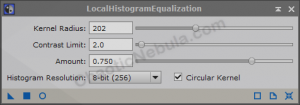The lunar color saturation process brings out subtle differences within the lunar landscape. The next step in the lunar image processing workflow is to increase the contrast of the structures within the image.
To do this, we use the Local Histogram Equalization process.


Local Histogram Equalization
Using local histogram equalization is a easy and fast process. It is useful to use the live preview as you adjust the settings.
Because I’m dealing with a 30% illuminated moon, I’m going to slightly increase the brightness, which will help enhance the color we will add later.
For the settings, the live preview will help nail down the best for your image.
- Kernel Radius: Determines how large of an area to use to calculate the histogram. Start with 100 and work up to 300. Usually deep sky images are around 150 and lunar are closer to 200.
- Contrast Limit: A value of 1 is no change. Usually 1.5 to 2 works well.
- Amount: How much will the new image be blended with the old. A value of .5 to .75 works well.

